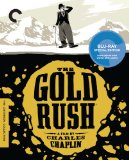| Reviews & Columns |
|
Reviews DVD TV on DVD Blu-ray 4K UHD International DVDs In Theaters Reviews by Studio Video Games Features Collector Series DVDs Easter Egg Database Interviews DVD Talk Radio Feature Articles Columns Anime Talk DVD Savant Horror DVDs The M.O.D. Squad Art House HD Talk Silent DVD
|
DVD Talk Forum |
|
|
| Resources |
|
DVD Price Search Customer Service #'s RCE Info Links |
|
Columns
|
|
|
Gold Rush, The
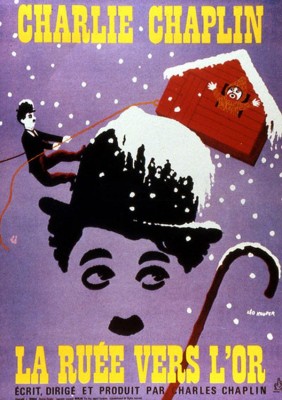
Please Note: All of the images used here are from promotional materials and are not taken from the Blu-ray under review.
Astutely predicting the outcry that would surely erupt from various Charlie Chaplin purists and completists were they to have put out only one Gold Rush or the other, Criterion is now releasing the 1925 classic as what amounts to one Blu-ray disc containing two distinct films, both essential in their own way to the Chaplin filmography: The original 1925 version, restored as closely as possible to the form in which audiences of that time would have seen it, and the re-release that Chaplin prepared in 1942, after the success of The Great Dictator compelled him to bring it out of the vaults and whip it into talkie shape for a world where silents were strictly old hat. It was this altered version, trimmed down to narrative economy, with a score and narration all done by the director, that Chaplin considered "definitive," and he more or less ignored the '25 cut from that point on. Now we have the opportunity to see both versions, each carefully brought up to the highest possible home-video standard, back to back and decide for ourselves whether it's the worldwide smash from 1925, the one that first took Chaplin's artistry and popularity both to new heights or the later, rethought, reworked "director's cut" that is the true, definitive, real Gold Rush.
It's not at all excessive, this Gold Rush/Gold Rush double feature; the film is sheer cinematic joy and mastery either way, and the differences are such that you really haven't seen the film (or at least haven't given it a fair shake) until you've seen them both. Despite significant differences between the two experiences (Gold Rush '42 features Chaplin's score and has his voiceover carrying the action through sharply written and delivered description, omitting all intertitles and removing some ostensibly superfluous plot, making for an overall more brisk and fable-like take), the underlying story and the visual and performative brilliance with which Chaplin conveys it through film remain more or less the same, and all the truly important, iconic moments are there in both tellings. Chaplin's instantly recognizable Little Tramp is here referred to as "The Lone Prospector," who's arriving in remote Alaska just before the turn of the (20th) century at the height of the Klondike Gold Rush, seeking his fortune. The film opens on some vast, beautifully location-shot, panoramic views of the teeming, struggling, collapsing hordes making their way over the treacherous, blizzard-blown Chilkoot Pass. But once we quickly hone in on our lone prospector (with really amazingly done studio art direction/matte work filling in perfectly for the opening snowy exteriors), it seems that he, unlike all the hopefuls we've just seen in the stage-setting opening (who are all twice his size, more appropriately attired, mightily equipped, and still collapsing from exhaustion), needs only his pluck, his cocky little shuffle-walk, and his omnipresent cane to traverse the steep rock faces and crevasses. There's a title card that comes up during the Tramp's antics much later in the film reading "Blissfully Ignorant," but most of the time, as in our first glimpse of him here, you don't need it spelled out; the little guy is a signifier unto himself, and all it takes is Chaplin's body language and facial expressions to get it across that "blissfully ignorant" applies to pretty much any situation this tumble-prone, uncourageous (but never ignoble), eternally resilient character happens to find himself in. What he's ignorant of as we first meet him in The Gold Rush is a huge bear lumbering just a few footsteps behind him as they cross the pass (the creature will turn up later and, in a manner of speaking, save Chaplin's life); the perkily bobbing-along bowler hat only turns for a wary backward glance at the brief moments when the beast is temporarily behind a corner or otherwise out of sight.
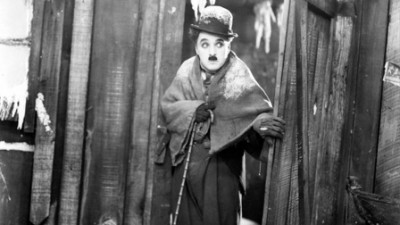
It's a sudden, very windy snowstorm that throws the prospector together with both his ally for the picture, Big Jim (Mark Swain), a fellow prospector who has just made his life-changing lucky strike when the storm arises, and his nemesis, the wanted criminal Black Larsen (Tom Murray), into whose hideout-cabin the storm blows the two prospectors. The storm is also the first major step in the film's ongoing dance with the elements that, taken more realistically, would be a tragedy or horror story, but in Chaplin's hands becomes the occasion for the lightest, deftest, most grin-inducing, imaginative inventiveness: the ensuing, prolonged bit has Black Larsen trying to eject the little prospector from his cabin, an intention thwarted as the snowy, gale-force wind makes exiting physically impossible before the other door is thrown open and all three are whipped in and out of the space like so many swirling, twirling snowflakes themselves. This is simply but elegantly blocked, with the framings, comedically choreographed movements of the characters, and editing creating swift, continuous dynamism despite the static camera. It's a piece of great comic filmmaking that's topped only by an analogous sequence near the end of the film, when the Lone Prospector and Big Jim find themselves inside a cabin teetering on a cliff's edge, their interior movements shifting the balance, the frame tilting back and forth to reflect the shack's wobbling as they scramble bewilderedly back and forth inside.
That precariously-balanced cabin at the film's final stretch, the penultimate event before its breezily happy end (perhaps even implausibly so, hence its alteration by Chaplin for the '42 version) comes only after any number of further setbacks/tortures transformed into iconic cinematic mirthmaking: the shoe poor Chaplin is forced to boil for Thanksgiving dinner in order to stave off his and Big Jim's starvation (and just in order to fend off the massive, generally well-intentioned lug, who, in another flash of hilariously clever visual sleight of hand, has hallucinated his little friend, whose jerky, uncontrollable movements do actually resemble those of a chicken, as a potential piece of poultry for his growling stomach); the "dance" with the two forks and two dinner rolls that's part of a fantasy sequence in the second act, when the prospector, saved from starvation and the specter of cannibalism, shambles into town and develops a heartbreakingly impossible crush on Georgia (Georgia Hale), who, succumbing to a pattern that will be ruefully recognizable to any heterosexual male, infinitely prefers the dashing, womanizing jerk Hank (Henry Bergman) to the sweet little guy who actually loves her and whom, in another little bit of bittersweet comedy, she literally finds invisible even when his face, with its longing eyes, is inches from hers.
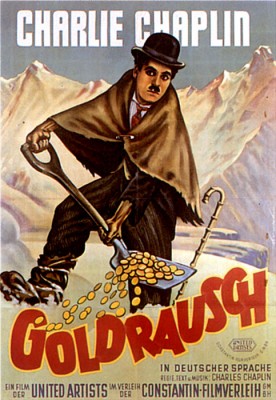
Misused by Georgia to provoke Hank's jealousy (when she defiantly invites the little prospector to dance, the camera exhilaratingly slow tracking in and seeming to glide along with them for a moment in what becomes yet another comic set piece, this time involving a rope the Tramp uses to hold his pants up that just happens to be attached to a dog on the other end), the sad, sweet little guy is left to fantasize regaling his object of affection and her dancing-girl pals with his dinner-roll improvisations, when in reality he's been stood up for Hank (on New Year's Eve, no less) by the not so much cruel as careless Georgia, who's forgotten about her promised New Year's engagement with that oddly mustachioed, bowler-hatted man whose poorly disguised attraction is always causing his already unique degree of clumsiness to become even more pronounced. Of course, with or without Georgia (I'll leave you to guess, no "spoilers" here), the lone prospector lands on his feet when he, Big Jim, and the latter's gold-rich claim are reunited, and we're happy for him. But his final good fortune pales in comparison to the film's nonstop real triumphs, the ones where Chaplin's hapless, blindly forging-ahead, physically spontaneous and in-the-moment presence have spun comic gold from one potentially dead-serious physical, mental, or emotional injury after another.
Whichever version of The Gold Rush you decide is the "definitive" one (and, call me stuffy and obsessive, but I'll take the original film first seen by audiences the world over, despite its ostensibly overelaborate plot, over the Chaplin-endorsed one with his funny and well-read but still slightly odd-feeling narration, which strikes me as more anachronistic in 2012 than the silent/intertitled '25 work), the markers of greatness are there. They're inside of and between the frames, in Chaplin's perfected-by-leaps-and-bounds mise-en-scène; his bottomless inventiveness as a writer, player, and ringmaster of comedy; and his supple, smooth use of what was fast becoming now easily recognize classical Hollywood editing (fluid, unobstructive; it's not right for everything, and it hasn't always worked, but the illusion of unimpeded movement created in the montage is perhaps better suited to what Chaplin was up to than almost anything else). With The Gold Rush, it becomes more difficult to say whether Chaplin's cinema is a delivery system for that indelible, near-universally familiar and beloved comic persona, or whether that character has become his ticket into the bigger, more ambitious aesthetic leagues. As was later the case with one of his best-known successors, Woody Allen, Chaplin had made brilliant, fantastically funny, well-made pictures before, but it took a bold leap forward for the public to consider him a filmmaker by vocation, not just a comedian who did pictures. The Gold Rush is his Annie Hall: he made even greater films afterward, but it's the first major, undeniable signpost on his route from great funnyman to world-class auteur, a milestone that has become a mecca for anyone -- whether it's a five-year-old who's barely ever seen a film or a persnickety, thirtysomething, art house-haunting reviewer -- at all capable of appreciating the pleasures exclusive to the movies.
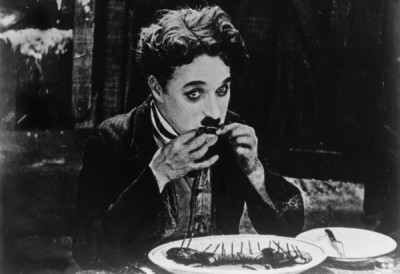
THE BLU-RAY DISC:
Both the information in the booklet and a pre-film onscreen crawl of text in the 1925 version explain that the '42 version, being Chaplin's favorite, preferred iteration of The Gold Rush, left the original, silent one rather orphaned, so the higher-definition, nicer-looking Gold Rush is the one from '42, not least because the source materials were much better-preserved to begin with. Truth be told, though, both versions look great: The Gold Rush circa 1925 does, indeed, have more instances of wear, tiny scratches, and flicker (particularly in the parts that were excised by Chaplin in the early '40s -- bits that, we are told, also had to be slightly re-cropped because many of them were recovered from sound prints, where the soundtrack on the film itself butted into the original framing), but it still looks much cleaner, richer, and overall nicer than any old print ever would have, so the warnings of the differences between the versions must be a pure formality adhered to out of characteristic conscientiousness, as they're noticeable in the '25 picture but really not drastic at all. The '42 film does look a bit better, with very little only the barest traces of old-print flickering , scratches, and debris. Both feature an abundance of consistent, beautiful, intentional celluloid grain, so nobody went DNR-happy in the cleanup process (this, too, is more typical of Criterion than some other, less careful distributors). Both versions are encoded in an AVC/MPEG-4 file, mastered at 1080p, and presented at the original aspect ratio of 1.33:1.
Sound:The 1925 version is presented with a DTS-HD Master Audio 5.1 soundtrack featuring composer Timothy Brock's adaptation of Chaplin's original score for the film; the sound is beautifully clear, clean, and vibrant. The 1942 version's soundtrack -- the one released with the film at that time -- is presented in PCM uncompressed monaural sound, and it also extremely well-restored, hitting the ear freshly just like it was recorded yesterday. I detected no audio flaws anywhere throughout either version.
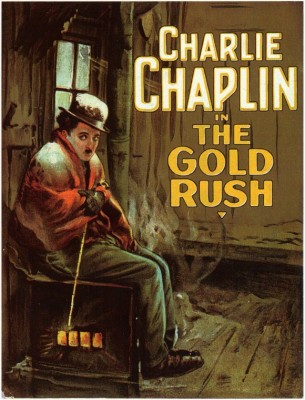
--A feature-length audio commentary with Chaplin scholar/biographer Jeffrey Vance. Vance's over-enunciation and hyperbole -- which, not too often, but occasionally, give him the air of a used-car salesman -- can't undermine his clearly vast base of knowledge and experience vis-à-vis Chaplin and his work, so the commentary is packed with observant analysis and behind-the-scenes/biographical detail and educated conjecture, as well as explanations of what was cut and why for the "definitive" 1942 version.
--"Presenting The Gold Rush," a 15-minute piece created for this release, in which Vance and Kevin Brownlow, one of the filmmakers who restored the 1925 version, further detail the reasoning for Chaplin's abandonment of the original 1925 epic success. They also go into the fascinatingly tangled and painstaking logistics (tracking down, gauging, and restoring the best source materials) and technical details of Brownlow's and David Gill's 1993 reconstruction of the original-release rendition of the film.
--"Chaplin Today: The Gold Rush,", a supplement rescued from the now decade-old M2K Chaplin DVD re-releases, is a half-hour program celebrating the film's long-running status as a beloved classic, along with its far-reaching effects (extending all the way to contemporary African filmmaker Idrissa Ouedraogo, interviewed here). Also included are archival footage of interviews with Chaplin's ex-wife (and The Gold Rush's original "Georgia"), Lita Grey, and with Georgia Hale, also a Chaplin paramour, who ultimately played the girl/love interest in the film.
--"A Time of Innovation: Visual Effects in The Gold Rush," a 20-minute program with Craig Barron, a visual effects practitioner and aficionado (aided by archival audio comments by the film's cinematographer, Roland Totherho) walking us through admiring explications of how Chaplin and team created the film's special effects -- which, as the title suggests, were incredibly innovative (and, from our point of view, unthinkably and impressively painstaking and work-intensive) for the time.
--"Music by Charles Chaplin," a 25-minute piece program in which silent-film composer/conductor Timothy Brock, long associated with the restorations and re-releases of Chaplin's work, talks about the ins and outs of silent film composing, his own direct experiences with the Chaplin Estate after they invited him to go through and adapt the scores Chaplin had written, and his personal insistence upon remaining faithful to Chaplin's musical visions as he carries their legacy forward.
--Four theatrical trailers from some of the 1942 version's international re-releases.
--A 26-page booklet featuring a new appreciation of the film by essayist/frequent Criterion booklet contributor Luc Sante and a reprint of James Agee's Time review of the 1942 re-release.
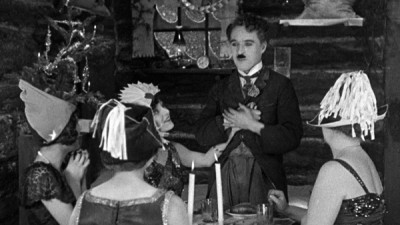
Barring any egregious botching of image or sound in the process of getting the film onto disc, The Gold Rush is a shoo-in for the DVD Talk Collector Series, and lo and behold, Criterion does a (not altogether unsurprisingly) marvelous job of giving us both the original 1925 silent version and Chaplin's 1942 "with words and music" re-release looking and sounding their very best, every visual and aural cinematic property preserved as close to perfection as possible. And what cinematic properties this film has! Chaplin was already the biggest celebrity the world had yet known by the time he made The Gold Rush, but revisiting it always reminds one that the film represented a new level of maturity and sophistication for Chaplin the director: it integrates that timeless "Little Tramp" character of his into the most expansive, well-realized, permanently memorable settings so far. As Chaplin would later show us again, the aesthetic stakes raised ever higher, in City Lights and Modern Times, the shuffling, eternally hapless but indefatigably optimistic little guy is possessed of the miraculously un-self-conscious ability to transform the world around him (which is mundane and alienating when it's not actually abject or dangerous) into a magical place where the laws of realism and hard knocks simply do not apply, where every dance with death and humiliation is just that: a dance, an opportunity for joyous physical expression between the struggling Homo sapiens and the hostile nature, objects, or other people around him.
Any halfway engaged viewer of The Gold Rush (and you'd have to make a tremendous effort not to be engaged by Chaplin's comedic choreography, both in front of and behind the camera, as well as from behind the editing table) will sense that whether or not Chaplin's lone prospector strikes it rich or fails is utterly beside the point: In The Gold Rush, whether you're surviving by eating your own shoe or improvising entertainment with utensils and dinner rolls, every despondent-making setback contains within it the opportunity for creative reclamation, some delightful alchemy through which misfortune becomes side-splitting or poignant (or both) art. It's the picture that sees Chaplin evolving from camera-savvy movie star to full-on genius at employing the visual and narrative properties of cinema, in a perfect marriage with his own beautifully conceived and executed persona, in order to convince us, for the brief, enchanted span of the film's running time, of what the Little Tramp knows intuitively, in his agile bones (the ones that can transform clumsiness into gracefulness, humiliation into exuberance): If you look at things the right way, there is no such thing as failure.
|
| Popular Reviews |
| Sponsored Links |
|
|
| Sponsored Links |
|
|
| Release List | Reviews | Shop | Newsletter | Forum | DVD Giveaways | Blu-Ray | Advertise |
|
Copyright 2024 DVDTalk.com All Rights Reserved. Legal Info, Privacy Policy, Terms of Use,
Manage Preferences,
Your Privacy Choices | |||||||









